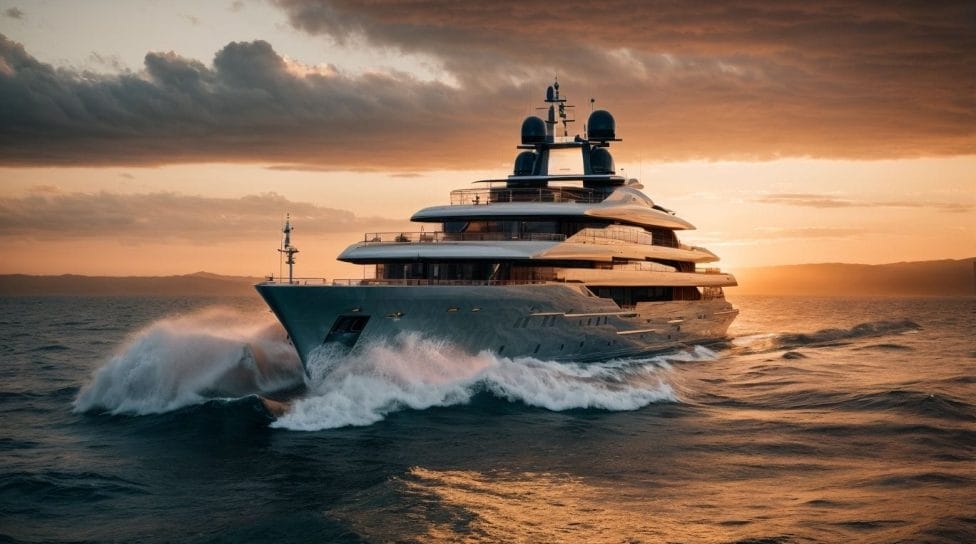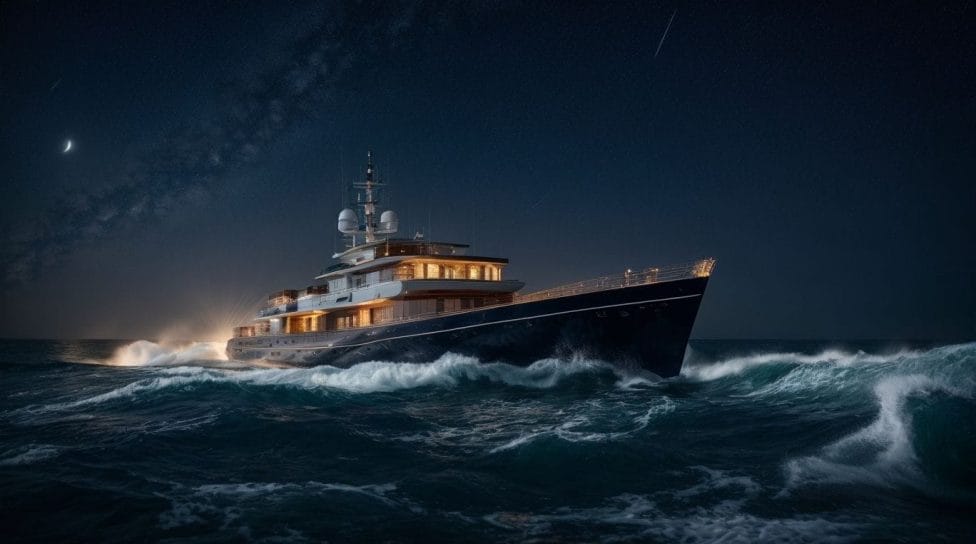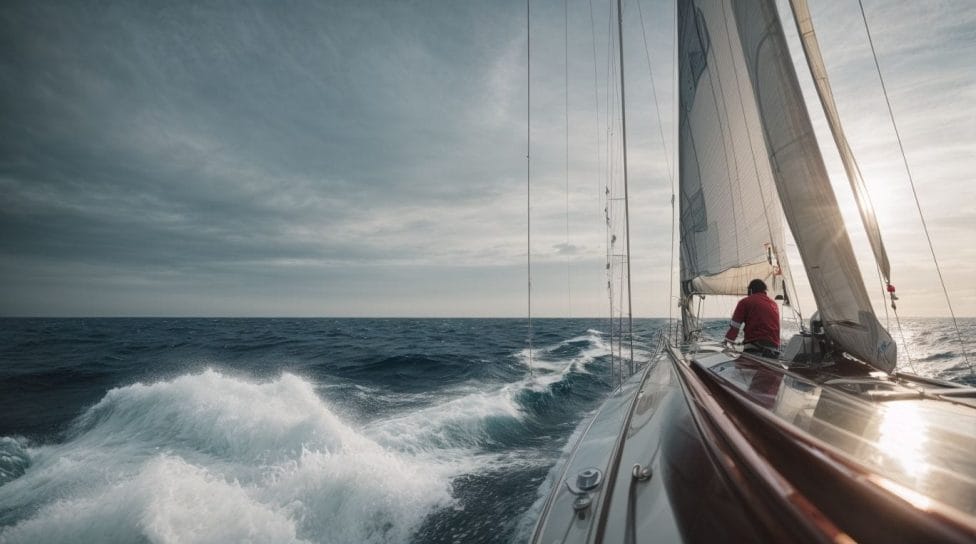Crossing an ocean in a yacht is an adventurous endeavor that captivates the imagination of many. However, it is essential to understand the capabilities and limitations of yachts before embarking on such a journey. A yacht, typically known for luxurious leisure cruising, comes in various types and sizes, each with its features and capabilities. In this article, we will explore whether a yacht can successfully cross the ocean, the factors determining a yacht’s ability to do so, the considerations for undertaking such a voyage, the challenges and risks involved, and the necessary preparations for a successful ocean-crossing journey. Understanding these aspects will help aspiring sailors and adventurers make informed decisions and ensure a safe and memorable voyage across the vast expanse of the ocean.
Key takeaway:
- Yacht size and design matter: The size and design of a yacht play a crucial role in determining its ability to cross the ocean. Factors such as hull shape, stability, and seaworthiness affect the yacht’s performance in open waters.
- Proper preparations are essential: Crossing the ocean in a yacht requires careful planning, route selection, and safety inspections. Adequate provisions, equipment, and training are necessary to ensure a safe and successful voyage.
- Challenges and risks of ocean crossing: Severe weather conditions, long journey durations, isolation, and technical issues pose significant challenges and risks when crossing the ocean in a yacht. Experienced crew members and effective communication systems are vital for overcoming these obstacles.
Can a Yacht Cross the Ocean?

Photo Credits: Jetsetlegion.Com by Richard Nelson
Yes, a yacht is capable of crossing the ocean. Yachts are purposefully designed and constructed to endure long journeys at sea while also equipped with essential navigation and safety systems to guarantee a prosperous voyage. These vessels can navigate vast bodies of water, including oceans, using meticulous planning and preparation. Sailboats, especially, are widely utilized for ocean crossings due to their unique capacity to utilize the wind’s power for propulsion. It is crucial to acknowledge that the success of an ocean crossing greatly depends on several factors, such as weather conditions, sea state, and the experience and expertise of the crew.
Understanding the Capabilities of Yachts

Photo Credits: Jetsetlegion.Com by Scott Nguyen
Understanding the capabilities of yachts is crucial when planning to cross oceans. Here are key factors to consider:
- Size and Design: Larger yachts with sturdy hulls and stabilizers offer better seaworthiness and comfort during long voyages.
- Fuel Capacity: Yachts need sufficient fuel capacity to cover long distances without refueling stops.
- Navigation and Communication Systems: Reliable navigation equipment and communication systems ensure safe navigation and contact with the shore.
- Seaworthiness: Yachts designed for offshore cruising are built to handle rough weather conditions and have self-righting capabilities.
- Crew and Safety: A well-trained crew and safety equipment are essential for handling emergencies and ensuring a smooth and secure voyage.
Understanding these yacht capabilities enables you to make informed decisions and embark on oceanic journeys confidently.
What is a Yacht?
A yacht, a watercraft, is designed to provide a luxurious experience for pleasure cruising or racing. What is a Yacht? It is usually owned by individuals with a passion for sailing and an interest in exploring the open waters. Yachts can vary in size, ranging from small sailboats to large motorized vessels. These magnificent vessels have various amenities, including cabins, entertainment systems, and kitchens, giving those on board a comfortable and enjoyable experience. Owning a yacht is often seen as a status symbol associated with elite individuals and extravagant lifestyles. It allows individuals to indulge in their passion for the sea, experiencing the freedom and adventure that it offers.
Types of Yachts
| Types of Yachts | Description |
| Sailing Yacht | Powered by wind and equipped with sails for propulsion. Ideal for those who enjoy a traditional sailing experience. |
| Motor Yacht | Powered by engines, offering speed and convenience. Often equipped with luxurious amenities and spacious interiors. |
| Explorer Yacht | It was built for long-range cruising and exploring remote locations. It is designed to withstand challenging conditions and has advanced navigation systems. |
| Sportfishing Yacht | Specifically designed for fishing enthusiasts, it is equipped with fishing gear, large decks, and ample storage for catch. |
True story: A couple decided to embark on a world tour on their sailing yacht. They chose a sturdy ocean-going yacht with all the necessary equipment and sailed across various oceans, exploring exotic destinations. Their sailing yacht allowed them to experience the freedom of the open sea and enjoy breathtaking sunsets in different parts of the world. It was a life-changing adventure that they will cherish forever.
Factors that Determine a Yacht’s Ability to Cross the Ocean

Photo Credits: Jetsetlegion.Com by Robert Johnson
A yacht’s ability depends on various crucial factors when crossing the ocean. Let’s unveil these factors and explore why they determine a yacht’s potential for oceanic journeys. From the size and design to the strength and stability, we’ll dive into how these elements play a role. We’ll delve into the importance of range and fuel capacity and the significance of navigation and safety features. Get ready to uncover what makes a yacht capable of conquering the open waters!
Size and Design
The size and design of a yacht play a crucial role in its ability to navigate the ocean. When considering a yacht for an ocean-crossing voyage, it is important to consider both size and design.
In terms of size, larger yachts offer more stability and storage space, which can be advantageous for long journeys. On the other hand, smaller yachts may be more agile in navigating tight spots, allowing for greater flexibility in challenging environments.
The design also plays a significant role. An aerodynamic design can reduce wind resistance, improving fuel efficiency and overall performance. An appropriate hull shape enhances stability in rough waters, making the yacht seaworthy.
Other factors to consider include range and fuel capacity. Yachts with longer ranges and more fuel capacity can go on longer journeys without frequent refueling. Moreover, features such as self-righting capabilities and reinforced hulls further enhance seaworthiness.
Strength and Stability
| Aspect | Description |
|---|---|
| Strength and stability | These factors, strength, and stability, are crucial when determining whether a yacht can cross the ocean. The yacht should have a strong, reinforced hull to withstand rough sea conditions for strength, while stability is provided by an adequate ballast system that keeps the yacht balanced in different sea conditions. A deep and sturdy keel also prevents excessive rolling, further enhancing stability. |
| Structural Integrity | Another important aspect to consider is the structural integrity of the yacht. The overall construction and materials should be high quality to ensure strength and durability. This ensures that the yacht remains strong and reliable throughout the journey. |
When considering a yacht for an ocean crossing, it is crucial to prioritize vessels that exhibit optimal strength and stability. Regular maintenance and inspections are necessary to ensure that all components, including the hull, ballast system, keel, and overall structure, remain in top condition. It is also recommended to seek expert advice and hire professional crew members with experience in long-distance voyages. This will not only maximize the safety of the journey but also enhance the overall enjoyment of the experience.
Range and Fuel Capacity
Range and fuel capacity are crucial factors determining whether a yacht can cross the ocean. The provided table offers detailed information on the range and fuel capacity of different types of yachts:
| Yacht Type | Range (nautical miles) | Fuel Capacity (liters) |
|---|---|---|
| Motor Yacht | 1,500 – 5,000 | 20,000 – 100,000 |
| Sailing Yacht | 1,000 – 3,000 | 10,000 – 50,000 |
| Expedition Yacht | 3,000 – 8,000 | 30,000 – 150,000 |
Understanding a yacht’s range and fuel capacity is essential in planning a successful ocean-crossing voyage. It ensures the yacht can cover the necessary distance while carrying an adequate fuel supply. Weather, provisions, and crew skills are crucial for a safe and enjoyable journey.
The first successful solo crossing of the Atlantic Ocean by yacht was accomplished in 1876 by Joshua Slocum. His voyage aboard the yacht Spray covered a distance of approximately 46,000 nautical miles and showcased the capability of yachts to cross the ocean.
Navigation and Safety Features
Navigation and safety features are crucial when crossing the ocean on a yacht. Here are some key features to look for:
- GPS and navigational systems: Accurate and reliable GPS systems are essential for determining the yacht’s position and course while prioritizing navigation and safety features.
- Communication equipment: VHF radios, satellite phones, and emergency beacons ensure reliable emergency communication, thus enhancing navigation and safety features.
- Life-saving equipment: Life rafts, life jackets, and EPIRBs (Emergency Position Indicating Radio Beacons) enhance safety during an ocean voyage while prioritizing navigation and safety features.
- Weather monitoring systems: Weather forecasting and monitoring equipment help avoid dangerous conditions and make informed route decisions, emphasizing navigation and safety features.
Fact: Proper navigation and safety features are vital in ensuring a safe and successful ocean crossing in a yacht.
Considerations for Crossing the Ocean in a Yacht

Photo Credits: Jetsetlegion.Com by Justin Thompson
Considering the thrilling adventure of crossing the ocean in a yacht, let’s explore the key considerations that play a crucial role in making this journey successful. From analyzing weather and sea conditions to ensuring ample provisions and well-equipped equipment, and even the skills and experience of the crew, we will uncover what it takes to navigate the vast oceanic expanse. So please fasten your seat belts and join us as we dive into the essential aspects of ocean-crossing in a yacht.
Weather and Sea Conditions
Weather and sea conditions -including forecasted weather patterns, wind speeds, and sea states- are crucial when considering crossing the ocean in a yacht. Understanding these conditions is essential for planning a safe and successful journey. Unfavorable weather and sea conditions, such as storms, heavy swells, or strong currents, can pose significant risks to the yacht and its crew. Monitoring weather updates throughout the voyage and making necessary adjustments to the route or plans is important. Skilled sailors with experience in handling various sea conditions can navigate challenging weather situations more effectively, ensuring the safety of everyone on board.
Provisions and Equipment
- The right provisions and equipment are essential to cross the ocean on a yacht. These provisions and equipment are crucial for ensuring the safety and comfort of the crew.
- Food and Water: Stock up on non-perishable food items and an ample supply of drinking water to sustain the crew throughout the journey.
- Communication Devices: Equip the yacht with reliable provisions and equipment like satellite phones, VHF radios, and emergency beacons to stay connected and request assistance if needed.
- Safety Gear: Have essential provisions and equipment such as life jackets, fire extinguishers, first aid kits, flares, and EPIRBs (Emergency Position Indicating Radio Beacons) readily available.
- Navigation Equipment: Install provisions and equipment like GPS systems, radar, and electronic charts to ensure accurate navigation. Also, have backup navigation tools such as compasses and paper charts.
- Energy Supply: Carry sufficient fuel for generators and engines and alternative power sources, like solar panels or wind turbines, to ensure a steady energy supply.
- Weather Forecasting: Stay updated on weather conditions by having reliable provisions and equipment like barometers and weather radios onboard.
- Repair and Maintenance Tools: Bring basic provisions and equipment for routine maintenance and repairs, including spare parts, engine oil, and a tool kit.
- Emergency Equipment: Prepare for emergencies with bilge pumps, extra lines, and rudders.
Crew Skills and Experience
Crew skills and experience are crucial for a successful voyage when crossing the ocean in a yacht. Here is a table highlighting the importance of crew skills and experience:
| 1. Navigation | Knowledge of celestial navigation, electronic navigation systems, and chart reading is vital for determining the yacht’s position and course. |
| 2. Seamanship | Proficiency in handling the yacht, including sail trimming, maneuvering, anchoring, and understanding of wind and sea conditions. |
| 3. Weather Forecasting | Ability to interpret weather forecasts, make informed decisions regarding route planning, and avoid severe weather conditions. |
| 4. Emergency Response | Training in first aid, knowledge of safety procedures, and the ability to handle emergencies, such as medical or equipment failure. |
| 5. Communication | Effective communication skills among the crew members and the ability to communicate with other vessels and receive important updates. |
Challenges and Risks of Crossing the Ocean in a Yacht

Photo Credits: Jetsetlegion.Com by Tyler Nguyen
Embarking on a yacht to cross the vast ocean is no easy feat. In this section, we’ll dive into the challenges and risks that come along with this daring adventure. From battling severe weather conditions and enduring long journeys to facing isolation and communication hurdles and dealing with technical issues and equipment failures, this thrilling sub-section explores the daunting obstacles sailors may encounter on their oceanic voyages. So fasten your seatbelts and prepare for a turbulent ride as we unravel the risks of crossing the ocean in a yacht!
Severe Weather Conditions
When planning a yacht voyage across the ocean, it is crucial to consider the potential challenges of severe weather conditions. These severe weather conditions can pose risks to the yacht and its crew. Here are a few factors to keep in mind regarding severe weather conditions:
- Storms: Yachts must be adequately prepared for severe weather conditions, including strong winds, heavy rain, and rough seas. Adequate navigation systems, storm sails, and emergency plans are crucial to navigate through storms.
- High Waves: Large waves can be extremely dangerous for yachts, potentially causing significant damage or even capsizing. Monitoring wave heights and avoiding areas with extreme wave conditions is vital to safeguard the yacht and its crew.
- Tropical Cyclones: In regions prone to cyclones, such as the Caribbean and Pacific, it is essential to plan voyages during non-cyclone seasons or stay constantly updated on weather forecasts to evade severe storms and ensure the yacht’s safety.
Understanding and adequately preparing for these severe weather conditions is vital to ensure the safety and success of a yacht crossing the ocean.
Long Duration of the Journey
The long duration of the journey is a significant consideration when crossing the ocean in a yacht. Depending on the route and weather conditions, it can take weeks or even months to complete the voyage. This means preparing for extended periods at sea, including provisions, water, and fuel. The crew must be mentally and physically prepared for prolonged isolation and limited communication. One true story that showcases the extensive length of an ocean-crossing journey is the tale of Laura Dekker, who, at the age of 14, sailed solo around the world in her yacht, spending over a year at sea.
Isolation and Communication
Isolation and communication are integral when embarking on an oceanic journey aboard a yacht. The sheer vastness of the ocean poses the risk of being cut off from external aid or communication networks. However, various proactive measures can be undertaken to mitigate these risks. An imperative step is to invest in dependable communication equipment, such as satellite phones and radios. Additionally, having backup systems and contingency plans in place is paramount. Regular check-ins with a shore-based support team are crucial to stay abreast of weather conditions and seek assistance if necessary. By prioritizing preparations for isolation and communication, one can significantly enhance safety and attain peace of mind throughout their ocean-crossing expedition.
Technical Issues and Equipment Failure
Technical issues and equipment failure are significant challenges that yacht owners and sailors may encounter when sailing across the ocean. These challenges can threaten the safety and success of the voyage. Ensuring the yacht is well-maintained and equipped with reliable equipment is crucial to minimize the risk of experiencing failures. Regular inspections, maintenance, and troubleshooting are vital in identifying and addressing potential technical issues before they become problematic. Additionally, having backup systems and spare parts onboard can help mitigate the impact of equipment failure during the journey. Furthermore, proper training and knowledge in yacht systems is essential as it contributes to swift troubleshooting and resolution of any technical issues.
Let me know if you need anything else.
Preparation for a Successful Ocean-crossing Voyage

Photo Credits: Jetsetlegion.Com by Billy Wilson
Preparing for a successful ocean-crossing voyage requires careful planning, thorough safety inspections, and continuous training. In this section, we’ll explore the essential steps you need to take to ensure a smooth and secure journey. From meticulously selecting the optimal route to conducting comprehensive safety checks and honing your sailing skills, we’ll provide the insights and tips you need to embark on a successful ocean-crossing adventure. So, tighten your life vest and get ready to set sail towards your epic voyage!
Planning and Route Selection
Careful route selection is crucial when planning and selecting a route for a yacht voyage across the ocean. It involves considering factors like distance, weather patterns, and navigational challenges. Here are some key considerations for planning and route selection:
| 1. Distance: | Determine the shortest and safest route that meets the yacht’s capabilities and fuel capacity. |
| 2. Weather patterns: | Study prevailing winds, currents, and potential storm systems along the planned route to anticipate challenges and ensure a smoother journey. |
| 3. Navigational challenges: | Evaluate hazards such as reefs, shallow waters, or restricted areas requiring alternative routes. |
| 4. Time of year: | Consider seasonal weather patterns and the availability of safe harbors along the planned route. |
| 5. Safety considerations: | Assess the availability of rescue and emergency services along the route to ensure adequate assistance in unforeseen situations. |
By carefully planning and selecting the route, yacht owners can maximize safety and enjoy a successful ocean-crossing voyage.
Safety Inspections and Maintenance
- Ensure To guarantee a secure and prosperous ocean-crossing voyage in a yacht; it is imperative to prioritize safety inspections and maintenance.
- Regular inspections: Conduct routine safety inspections of the yacht to identify potential issues or wear and tear.
- Hull maintenance: Keep the hull clean and free from marine growth by regularly cleaning and applying antifouling paint.
- Engine and systems checks: Regularly inspect and service the engine, propulsion systems, electrical systems, and navigation equipment.
- Safety equipment: Ensure all safety equipment, such as life jackets, flares, fire extinguishers, and first aid kits, are readily available and in good working condition.
- Sail and rigging maintenance: Inspect the sails, rigging, and mast to ensure they are in optimal condition.
- Emergency preparedness: Regularly review and update emergency plans, including procedures for man overboard, fire, and abandon ship scenarios.
- Communication systems: Verify the functionality of communication systems, including VHF radio, satellite phones, and distress beacons.
- Weather monitoring: Stay updated on weather forecasts and prepare for potential changes in sea conditions along the planned route.
- Provisioning and stock-up: Before the journey, stock up on sufficient food, water, fuel, and other necessary supplies.
By following these steps and ensuring proper Safety Inspections and Maintenance, yacht owners can minimize risks and enjoy a safe voyage across the ocean.
Training and Skill Development
Proper training and skill development are paramount for crossing the ocean in a yacht. Here are some key points to consider:
- Navigation skills: The ability to navigate using both traditional methods and modern technology is imperative.
- Maintenance knowledge: Understanding yacht systems and how to perform basic repairs and maintenance is significant during long journeys.
- Emergency preparedness: Learning first aid, safety procedures, and how to handle emergencies is vital for the safety of both the crew and the yacht.
- Weather interpretation: Developing the skills to interpret weather patterns and make informed decisions based on forecasts is necessary for avoiding severe weather conditions.
Pro-tip: Continuously improving your skills through courses, workshops, and hands-on experience will greatly enhance your confidence and competence in ocean-crossing voyages.
Some Facts About Can Yacht Cross Ocean:
- ✅ Many privately owned yachts cross the ocean for various reasons. (Source: The Oceanpreneur)
- ✅ The majority of yachts crossing the ocean are larger than 36ft, with the average size being around 44ft. (Source: The Oceanpreneur)
- ✅ Both monohull and catamaran yachts cross the ocean, with monohulls being more common. (Source: The Oceanpreneur)
- ✅ Superyachts, over 24 meters in length, are designed specifically for ocean crossings. (Source: Simpson Marine)
- ✅ Crossing the ocean on a superyacht offers more comfort and less risk than smaller yachts. (Source: Simpson Marine)




